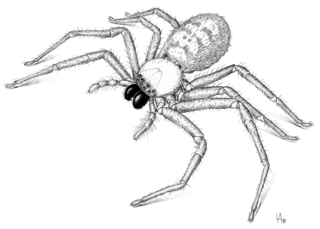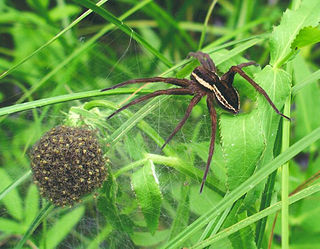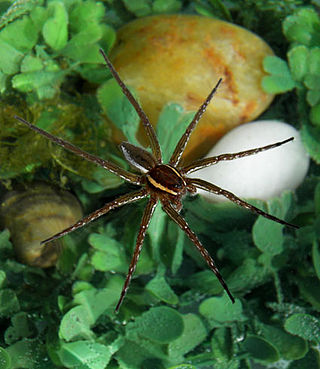
Huntsman spiders, members of the family Sparassidae, are known by this name because of their speed and mode of hunting. They are also called giant crab spiders because of their size and appearance. Larger species sometimes are referred to as wood spiders, because of their preference for woody places. In southern Africa the genus Palystes are known as rain spiders or lizard-eating spiders. Commonly, they are confused with baboon spiders from the Mygalomorphae infraorder, which are not closely related.

Delena cancerides, the communal huntsman, flat huntsman or social huntsman, is a large, brown huntsman spider native to Australia. It has been introduced to New Zealand, where it is sometimes known as the Avondale spider. This was the species used in the Australian movie Napoleon and widely in Arachnophobia, and all films depict them as having a deadly venomous bite, but they are generally considered harmless to humans in real-life. It was first described by Charles Athanase Walckenaer in 1837.

Wandering spiders (Ctenidae) are a family of spiders that includes the Brazilian wandering spiders. These spiders have a distinctive longitudinal groove on the top-rear of their oval carapace similar to those of the Amaurobiidae. They are highly defensive and venomous nocturnal hunters. Wandering spiders are known to hunt large prey, for example hylid species Dendropsophus branneri. Despite their notoriety for being dangerous, only a few members of Phoneutria have venom known to be hazardous to humans, but the venoms of this family are poorly known, so all larger ctenids should be treated with caution.

Dolomedes is a genus of large spiders of the family Pisauridae. They are also known as fishing spiders, raft spiders, dock spiders or wharf spiders. Almost all Dolomedes species are semiaquatic, with the exception of the tree-dwelling D. albineus of the southeastern United States. Many species have a striking pale stripe down each side of the body.

Philodromus is a genus of philodromid crab spiders. Spiders in this genus are distinctively flattened.

Ancylometes is a genus of Central and South American semiaquatic wandering spiders first described by Philipp Bertkau in 1880. Originally placed with the nursery web spiders, it was moved to the Ctenidae in 1967. The genus name is derived in part from Ancient Greek "ἀγκύλος", meaning "crooked, bent".

Ameerega trivittata, formerly Epipedobates trivittatus, is a species of frog in the family Dendrobatidae commonly known as the three-striped poison frog. It is found in Bolivia, Brazil, Colombia, Guyana, Peru, Suriname, Venezuela, possibly Ecuador, and possibly French Guiana.

Dendropsophus branneri is a small hylid tree frog endemic to the Atlantic Forest region of Brazil. It feeds mainly on arthropods and is preyed upon by various invertebrates and vertebrates. Although currently classified by the IUCN Redlist as "least concern", D. branneri suffers rapid habitat loss due to residential development, agriculture, logging, and clearing for pastureland. Male D. branneri are noted for their fighting call, which differs significantly in frequency, duration, and pulses per call compared to their mate advertisement call. Males are also noted for their willingness to escalate physical altercations against other males, which includes kicking, pushing, and wrestling their opponent into non-dominant positions. Unlike most other frog species, D. branneri can breed in both temporary and permanent pools allowing it to inhabit a wide variety of habitats leading to its wide distribution.

Dendropsophus phlebodes, the San Carlos treefrog or San Carlos dwarf treefrog, is a species of frog in the family Hylidae. It is found in western Colombia, Costa Rica, Nicaragua and Panama. Its natural habitats are tropical moist lowland forests, but it may also occur in disturbed habitats. It is threatened by habitat loss.

Callimedusa tomopterna, the tiger-striped tree frog, is a species of frog in the subfamily Phyllomedusinae. It is found in northern South America in the Upper Amazon Basin of Bolivia, Peru, Ecuador, and Colombia, Amazonian Brazil, and the Guianas from southeastern Venezuela to French Guiana. It might represent more than one species.

Ameerega is a genus of poison dart frogs in the family Dendrobatidae. These frogs live around rocks that are nearby streams. They are found in central South America north to Panama. It contains many former species of the genus Epipedobates.

The six-spotted fishing spider is an arachnid from the nursery web spider family Pisauridae. This species is from the genus Dolomedes, or the fishing spiders. Found in wetland habitats throughout North America, these spiders are usually seen scampering along the surface of ponds and other bodies of water. They are also referred to as dock spiders because they can sometimes be witnessed quickly vanishing through the cracks of boat docks. D. triton gets its scientific name from the Greek mythological god Triton, who is the messenger of the big sea and the son of Poseidon.

Ephebopus is a genus of northeastern South American tarantulas that was first described by Eugène Louis Simon in 1892. Its relation to other tarantulas is one of the most uncertain in the family, and it has been frequently moved around and has been placed in each of the eight subfamilies at least once.

Desis is a genus of intertidal spiders that was first described by Charles Athanase Walckenaer in 1837. Species of the genus are found in Australasia, the Pacific, Japan, eastern and southern Africa, and India. They are marine spiders, living in the intertidal zone and only emerging at the ebb tide to hunt for invertebrates including shrimp. When submerged during high tides, they stay in an air chamber sealed with silk, and breathe its air.
Ameerega yoshina is a species of poison frogs found in central Peru. It was found in the Huallaga Province. It resembles A. bassleri and A. pepperi, but can be differentiated by its advertisement call being slower than its relatives; approximately one-half the speed of A. bassleri and one-quarter the speed of A. pepperi.
Ameerega pepperi is a species of poison frogs found in central Peru. It has a red dorsum and is similar morphologically to A. bassleri, A. cainarachi and A. yoshina; but can be distinguished by its advertisement call.

Philodromus rufus, also known as the White-striped Running Crab Spider is a species of running crab spider in the family Philodromidae. It is found in North America, Europe, Turkey, Caucasus, Russia (Siberia), Central Asia, China, Korea, and Japan.

Ameerega shihuemoy, the Amarakaeri poison frog, is a species of dart frog endemic to a small region in southeastern Peru in the Manú District where it lives in the transition zone between montane rainforest and the lowland rainforest. The frog is a member of the Ameerega picta group. It was discovered at the Manú Learning Centre where it is known to occur in pieces of selectively logged forest. This species is threatened by habitat loss due to agriculture, gold mining, oil extraction, road construction, and logging. Currently the frog is only known from nine locations globally; three sites in the Manú Biosphere Reserve, and six in Amarakaeri Communal Reserve. Initially it was considered for a status of vulnerable or near-threatened, but due to its low number of known localities it has been considered endangered.
















